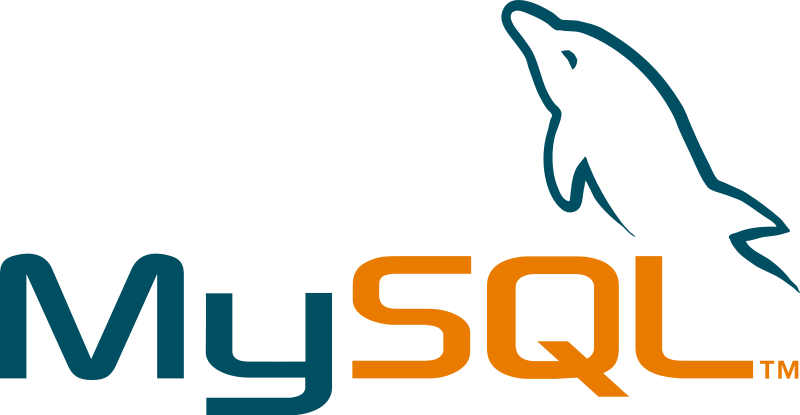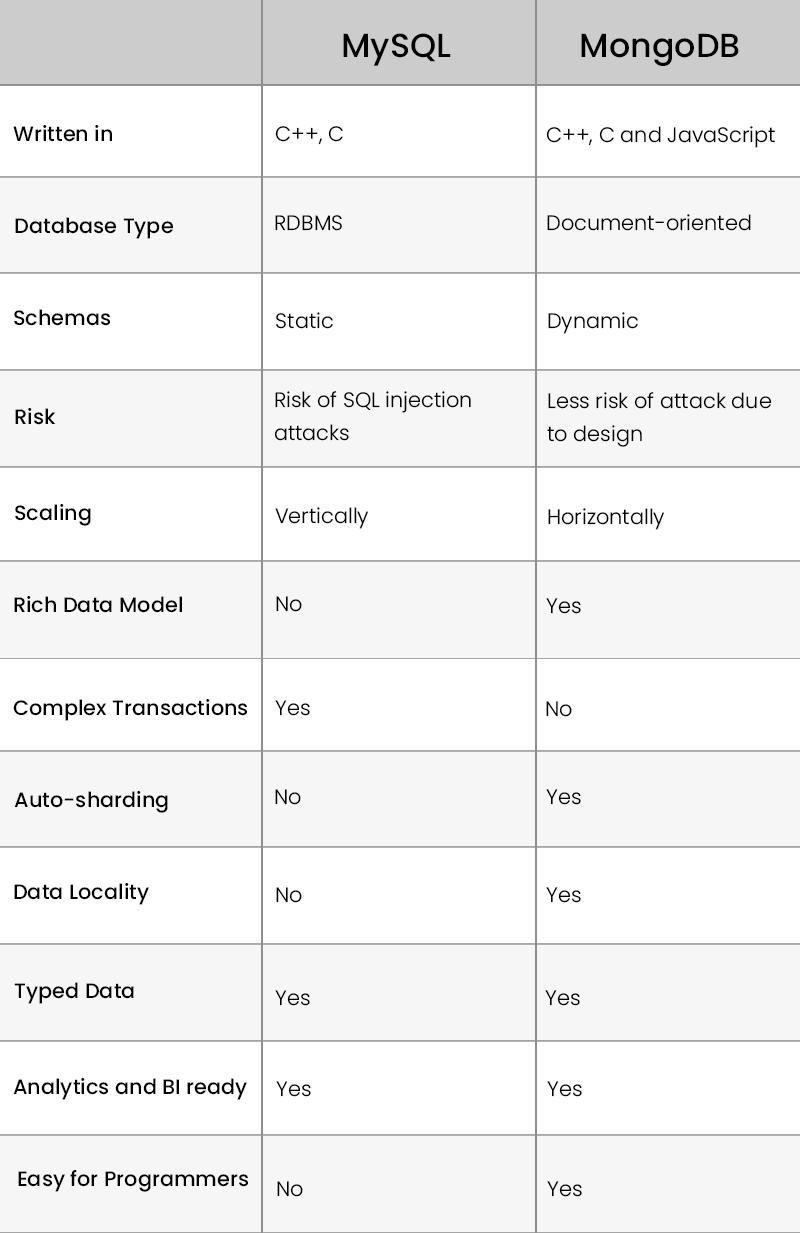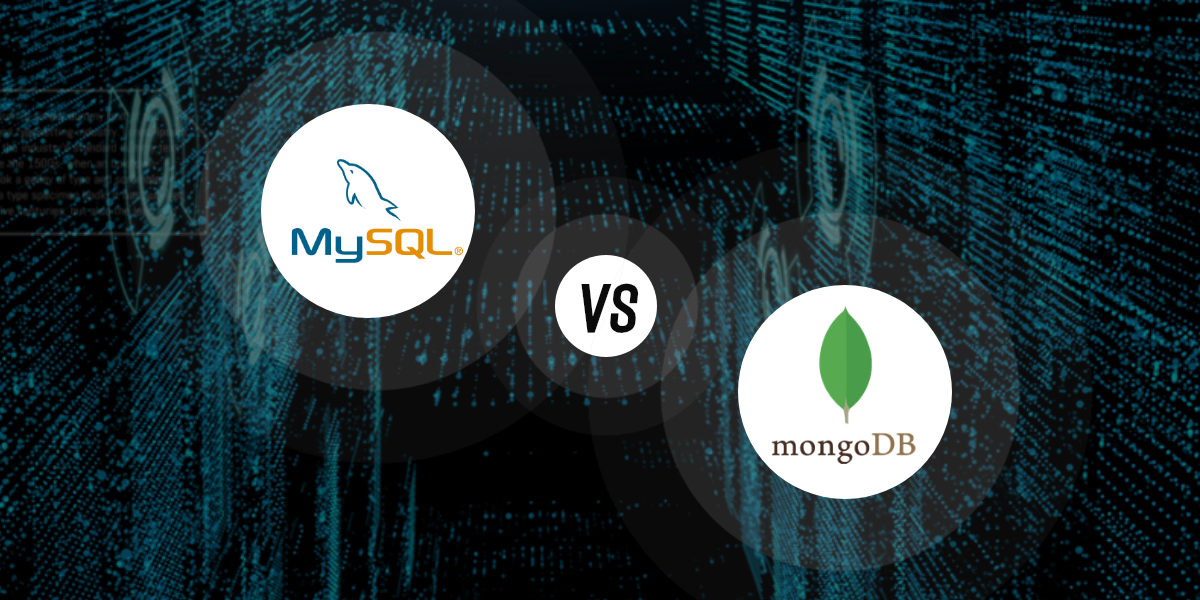MongoDB Vs MySQL: Which Database Best Suits your Business?
- Mobile
- April 16, 2019
Choosing a DBMS (Database management system) may land you up in a dilemma, with too many options to select from. Relational DBMSs like MS SQL, PostgreSQL and MySQL have been dominant in recent years.
Besides, you have non-relational DBMS like MongoDB, which are capable of dealing with massive volumes of data. You might have wondered which database is a better option between MongoDB and MySQL.
Here is a comparison between these two database management systems, which will give you a better concept about their applications.
What is MySQL?
As an open source RDBMS, (relational database management system), MySQL has gained extensive popularity over the years. It was originally developed by MySQL AB and now owned by Oracle Corporation. Based on the requirements, the users can pre-define the database schema and establish rules, capable of governing the relationship between relevant fields in the tables.

MySQL, like other relational DBMSs, uses SQL (structured query language) to get access to database and keeps the data stored in tables. For making any change in the schema, a migration procedure is necessary, that can reduce the performance of the application significantly. It can also take the database to the offline mode.
What is MongoDB?
MongoDB was developed by MongoDB, Inc and it is a popular non-relational database. Data is stored in this type of DBMS as documents in a form called BSON (a type of binary representation).

For query access, the MongoDB query language is used to store the related data. The fields may be different for each document, and you need not declare the document structure to the systems. These documents are self-explanatory in nature.
In case you need to add a new field to the document, you can create it, without making any change to the other documents present in the collection. The central system catalog does not require any update and you need not take the system to the offline mode. You can also use schema validation optionally to enforce the control of data over each of the collections.
The document data model of MongoDB maps objects in the application mode naturally. As a result, developers find it simple to master and use. The users can also represent the hierarchical associations to the store arrays seamlessly, along with other complicated structures.
MongoDB vs. MySQL: Pros and Cons
Both MongoDB and MySQL have gained popularity as open-source database software. However, each of them is suitable for a particular situation. Have a look at the pros and cons of MongoDB and MySQL.

Flexibility of the Schema
MongoDB has a good advantage over MySQL, as the users face no constraints in terms of schema design. Some of the documents can be dropped by the developer within a collection. It is not necessary for the documents to have any relationship among each other.
The supported data structures form the only drawback of this system. The schema needs to be optimized continually, based on how the data will be accessed by the application. This is because, transactions and joins are absent.
Before a user can store data in MySQL, it is necessary to define every row, column and table. It is also necessary for all the rows in the table to have the same columns. This restricts the degree of flexibility, when it comes to storing data.
In MongoDB, the documents are devoid any schema, that is capable of storing any data that the user desires. However, you may face issues with the consistency of data at times. MySQL is bound to make errors, as a strict schema-template is involved in the process.
Query Language
The query language in both MongoDB and MySQL is strong. An unstructured query language is used in MongoDB. A document specification with the respective properties is necessary, if you want to develop a query in JSON documents and match the results.
During the execution of MongoDB, a set of operators is used, and these are related to JSON. MongoDB supports boolean OR queries, although the users need to use operator ($or) in the process.
MySQL, on the other hand, operates on the structured SQL language, while interacting with the database. Although it is quite simple, the language is very powerful and consists of two parts:
- Data Manipulation Language (DML)
- Data Definition Language (DDL)
Relationship
The JOIN operation is not supported by MongoDB. Instead multi-dimensional types of data like arrays are supported by it. The term ‘embedding’ is used to define the position of one document inside another.
The JOIN operation is one of the best aspects of MySQL. It executes the relational database and enables one to merge data from multiple tables using the SELECT command in a single query. Therefore, the users can seamlessly get the associated data using a single statement in various tables.
Speed and Performance
MongoDB can control large volumes of unrestricted data, as compared to MySQL. As it enables the users to query in a way sensitive to workload, it has a much faster speed.
MySQL, when compared to MongoDB, is considerably slower, when you use large volumes of data. It cannot deal with unstructured data, when the volume is greater. However, you do not have any standard benchmark, which can help you choose the right database for your requirements. Only the data, infrastructure and your needs can evaluate what a user needs to know.
Security Model
MongoDB can establish its control over a variable set of privileges. In MongoDB, the key security features include authorization, auditing and authentication. You will also find it feasible to use Secure Sockets Layer (SSL) and Transport Layer Security (TLS) to encrypt the ends. This ensures that only the intended client can read the documents.
A security model based on privilege is used in MySQL. This indicates that a user is authenticated by MySQL and can benefit on database like UPDATE, SELECT, INSERT and CREATE.
When to Use MongoDB for Business Application?
You should use MongoDB for business application when you:
- Use cloud-based services
- Want to cut down the cost of schema migration, in case it is unstable
- Do not have any database administrator
- Need built-in sharding solutions
When to Use MySQL for Business Application?
You should use MySQL for business application when you:
- Have a limited budget
- Have a fixed schema
- Prioritize data security
- Need high transaction rates
Should You Use MongoDB Instead of MySQL?
Business firms of various sizes are using MongoDB, as they can develop the applications much faster and deal with data of all types. Besides, they can gain more efficiency in managing applications.
When you use MongoDB, the complicated layer of ORM (object-relational mapping) is eliminated. This helps in translating the objects in the relational tables. The data model is much more flexible, which indicates that one can adjust the database schema according to the business needs.
You can also scale MongoDB within multiple distributed data centers as well as across these platforms. In the process, it provides the users with new levels of scalability and availability, which they did not enjoy earlier with MySQL.
As the deployments keep growing in terms of throughput and data volume, MongoDB can be scaled without any downtime seamlessly. Besides, you need not change the application.
On the contrary, one needs to carry out custom engineering tasks to achieve the scale with MySQL. Eventually, many organizations have already migrated to MongoDB from MySQL.
If you are still confused regarding the choice of right database or you want to migrate from MySQL to MongoDB, feel free to consult our tech-savvy experts to guide you in your project.













